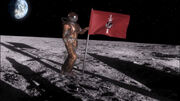AT: "xx"

Luna fired upon by the verteron array.

In the mirror universe, a Terran Empire astronaut lands on the surface of Luna
Luna, known on Earth as simply the Moon, was the only natural satellite of the planet Earth.
Astronomical data
Location
Sol system, Sol sector (Sector 001), Alpha Quadrant
A Federation star chart depicting the location of Sol.
Further information
Historical
The first manned Human landing took place in 1969 by Apollo 11, a NASA mission initiated by the Earth nation-state of the United States of America. (TOS: "Tomorrow is Yesterday", "Return to Tomorrow")
The first man to walk on the Moon was Neil Armstrong, who said "That's one small step for [a] man, one giant leap for mankind." Shannon O'Donnell remembered watching it on television when she was eleven years old, and still had dreams about it inspiring her career with NASA in 2000. (VOY: "11:59")
In the mirror universe, the Terran Empire landed on the Moon, planting a flag there to signify their achievement. (ENT: "In a Mirror, Darkly" opening credits)
In the late 21st century the Lunar colonies were founded. People who live in those colonies, even by the 24th century, still refer to Luna as "the Moon", though outsiders are often surprised by this. (DS9: "Valiant")
In 2063, Luna's gravitational field obscured the USS Enterprise-E's warp signature and the Vulcan starship, the T'Plana-Hath did not detect it in Earth orbit while making First Contact with Humans. (Star Trek: First Contact)
In 2155, John Frederick Paxton used the hijacked verteron array on Mars to fire on Luna, as a demonstration of the array's power. (ENT: "Demons")
The USS Defiant passed Luna on its way to Earth in 2371. (DS9: "Past Tense, Part I")
Political
As a major Human settlement, Luna falls under Federation jurisdiction and protection.
"Terra Prime", a xenophobic group of Humans which manifested in 2155, originated from the Orpheus Mining Colony on the Moon.
In the 24th century there are over 50 million people living on the Moon. (Star Trek: First Contact) In Earth slang people who lived on the moon were called Lunar schooners. The occupants of Luna were aware of this but chose not to use the term on the moon. (DS9: "Valiant")
Geographical
Luna is about one-eightieth the mass of Earth, and has one-sixth its gravity. It is tidally locked, with one side always facing Earth.
Amongst the moon's most striking features are the maria, vast dark and flat plains formed by basaltic upwelling or lava flows. In one such mare, Mare Tranquillitatis, or the "Sea of Tranquility", lies the site of the first Human landing on the Moon, Tranquility Base.
One location on Luna is Lake Armstrong, which is visible from Earth. (Star Trek: First Contact)
Depictions in the Apollo program
Luna was a central theme in the mission insignias for the Apollo program in the 20th century. The first depiction of Luna was in the program's insignia. The insignia depicted the path of the spacecraft from a launch site in Florida to a landing site somewhere on Luna. Sun god Apollo was drawn into the features of Luna. As each mission grew closer to landing, the features of Luna became more detailed with cratering and suggested the ship either orbiting above or landing on Luna. By Apollo 15, the lunar features were the dominant image of the insignia. The last lunar mission, Apollo 17, suggested that the program was the first step in man's progression to the stars with Apollo looking beyond Luna to Saturn and to a distant galaxy. (ENT: "First Flight")
Other information
When attempting a lucid dream to contact a species of aliens, Chakotay used the image of the moon to alert him to the fact that he was dreaming. Chakotay saw the moon three times – once outside the USS Voyager from the mess hall, once on a monitor screen in Cargo Bay 2 after he'd apparently woken up to warn him he was still asleep and under the aliens' control, and once more on the main viewscreen in the bridge when he dozed off and was slipping back into the aliens' grip. (VOY: "Waking Moments")
Locations

A 22nd century lunar settlement from orbit
- Copernicus Ship Yards
- Lunar colonies
- Lake Armstrong
- Luna Shipyards
- Lunaport
- Copernicus City
- Lunar One colony
- New Berlin
- Orpheus Mining Colony
- Tycho City
- Tranquility Base
- Armstrong City
Background Information
The Vulcanis Lunar Colony was presumably not located on a moon of Vulcan, as it does not have any moons. Given its name, it may be on Luna.
According to the Star Trek: Star Charts, on page 32, Luna (Sol IIIa) was a Class D world. The first of the lunar colonies was founded in 2039, and Luna became a charter member of the United Federation of Planets in 2161. In 2378, there were 50.2 million humans living on Luna, and the capital was Tycho City. Major attractions included Tranquility Base, Lake Armstrong, New Berlin, and Lunaport. On page 36, Luna orbited a planet, Earth that itself orbited a G-type main-sequence star. On page 38, Luna was given the following specifications:
- Diameter: 3,476 km
- Distance from Earth: 384,500 km
- Surface Temperature: -155 °C to 105 °C
- Rotation Period: 27.3 days
- Orbital Period: 27.3 days
- Gravity: 0.16 standard
- Orbital Facilities: Lunaport
